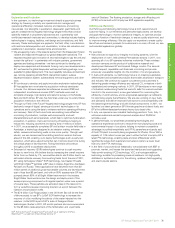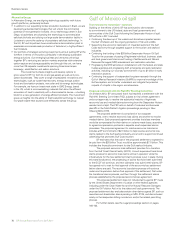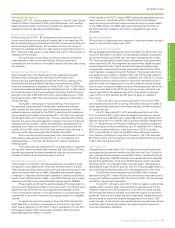BP 2011 Annual Report Download - page 69
Download and view the complete annual report
Please find page 69 of the 2011 BP annual report below. You can navigate through the pages in the report by either clicking on the pages listed below, or by using the keyword search tool below to find specific information within the annual report.
Business review: BP in more depth
BP Annual Report and Form 20-F 2011 67
Business review
We have estimated and communicated delivery timelines for each of the
recommendations and will continue to provide periodic updates of our
progress. These timelines are based on existing facts and circumstances
and can shift due to complexity, resource availability and evolving
regulatory requirements.
The BP board has identified an independent expert to provide
further oversight and assurance regarding the implementation of the
Bly Report recommendations. The independent expert’s engagement is
expected to commence in the latter half of May 2012.
Progress update
At the end of 2011, four of the Bly Report recommendations have been
completed. These were:
• Recommendation 6: to propose a recommended practice for foam
cementing to the American Petroleum Institute.
• Recommendation 8: to strengthen the technical authority’s role in
cementing and zonal isolation.
• Recommendation 13: to strengthen our rig audit process to improve
closure and verification of audit findings across the rigs we own and
contract.
• Recommendation 14: to establish key performance indicators for well
integrity, well control, and rig safety-critical equipment.
We continue to make progress on all of the remaining recommendations
largely in line with our planned schedule, with a further 12
recommendations expected to be completed in 2012. Progress is tracked
in the quarterly HSE and operations integrity report supplied to the
executive team. See bp.com/internalinvestigation for the full report and
quarterly updates on progress.
External investigations
In addition, there have been a number of external investigations, including
those of the National Commission on the BP Deepwater Horizon Oil Spill
and Offshore Drilling (oilspillcommission.gov) and the Joint Investigation
Team of the Bureau of Ocean Energy Management, Regulation and
Enforcement and the United States Coast Guard
(boemre.gov/ooc/press/2011/press0914.htm). These reports were
consistent in their conclusions that the accident resulted from multiple
causes and was due to the actions of multiple parties. We are committed
to understanding the causes, impacts and implications of the Deepwater
Horizon incident and to learn and act on lessons from it. As part of this
commitment, BP is reviewing the recommendations from government and
industry reports.
Capping and containment
We have developed a mobile deepwater well capping package that
includes about 250 pieces of speciality equipment. Maintained in a
constant state of readiness in Houston, it is designed to be deployed by
air freight and arrive wherever it is needed in just a few days.
We also share capping and containment equipment with other
operators in the Gulf of Mexico, through the Marine Well Containment
Company, as well as with operators in the UK North Sea. Further, BP
provided project management for the Oil and Gas UK Oil Spill Prevention
and Response Advisory Group to develop a next generation well capping
system, now available in Europe, and is one of nine companies working in
the Subsea Well Response Project to enhance the industry’s capability to
respond globally to subsea well control events.
Relief wells
In responding to the Gulf of Mexico oil spill, we drilled two relief wells.
Prior to drilling a deepwater well, BP operations now have relief well plans
in place with equipment identified that can be moved to the site if needed.
This is of particular benefit in areas that do not have the same infrastructure
and support as more active basins such as the Gulf of Mexico.
Oil spill preparedness
We continue to develop and assimilate lessons from the response to the
Gulf of Mexico oil spill. In 2011, as a priority we incorporated many of
these lessons into new technical requirements for BP operations that drill
in deepwater. Conformance with these requirements is mandatory for all
operations drilling in water deeper than 1,000 feet and is subject to a formal
assessment and sign-off by technical experts, S&OR and senior leaders.
During 2011, we began implementing these requirements in Angola, the
North Sea, Brazil, the US and Egypt, where we have deepwater drilling
active or planned for 2012.
Crisis management
Crisis management planning is essential to respond effectively to
emergencies and to avoid a potentially severe disruption in our business
and operations. The intention is to build on interim requirements introduced
in 2011 for deepwater drilling to put in place group-wide practices for both
oil spill preparedness and response and crisis management.
During the response, we updated our incident action plan – an
operational crisis planning tool – every 12-24 hours, which allowed us to
have recent information to aid decision making. This was made possible by
developing a common operating picture (COP) which helped us collect and
present information in a way that enabled faster, better-informed decisions.
The COP created an integrated view across more than 200 different data
types. It provided an instant, interactive picture of the spill status and the
activities of all responders.
See Environmental and social responsibility on pages 69-73 for
further information on BP’s approach to oil spill contingency planning and
response.
Safer refining
We have been working hard to apply the lessons learned from the
tragic accident in our Texas City refinery in 2005 and are committed to
implementing the recommendations of the BP US Refineries Independent
Safety Review Panel.
Systematic management
The core business of our refineries is the safe storage, handling and
processing of hydrocarbons which involves systematic management of the
associated operating risks. In seeking to manage these risks, measures are
taken by our refineries to:
• Prevent loss of hydrocarbon containment, such as oil spills, through
well-designed, maintained and operated equipment.
• Reduce the likelihood of ignition of any hydrocarbon releases which may
occur through controlling ignition sources.
• Provide safe locations, emergency procedures and other mitigation
measures in the event of a fire or explosion occurring.
For example, across our refining business we are spending more than
$700 million to install safety shelters for individuals, move people further
away from hydrocarbon containing equipment and reduce the number of
vehicles in our sites.
In 2011, we enhanced and standardized a number of technical
practices that we intend to implement across our refining business in 2012
and 2013, including practices pertaining to:
• Control of work practices including rules for what work is done, who it is
done by, where it is done, when it is done and how it is done.
• Isolation of equipment from hydrocarbon and other energy sources to
safely allow maintenance.
• Design, operation, maintenance for instrumented systems throughout
their lifecycle to reliably achieve or maintain a safe operating state if
unacceptable or dangerous process conditions are detected.
• Procedures and equipment requirements to assure safe handling of
hydrogen sulphide containing streams.
• Design and operation of existing fired heaters.
• Identifying operating limits for our processes and equipment.
Risk assessment, prioritization and management
In 2011, all refineries used a consistent methodology to identify risks and
prioritize mitigation actions, including addressing low probability, high
consequence scenarios. Action plans have been developed for each risk
and reviewed by authorized line and S&OR leaders. A multi-year risk profile
reduction plan has been approved for each refinery and, learning from
























